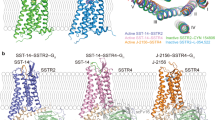Abstract.
The five human somatostatin receptor subtypes (hsst1–5) were stably expressed in CCL39 cells (Chinese hamster lung fibroblast cells) to study the inhibition of forskolin-stimulated adenylate cyclase (FSAC) activity induced by somatostatin (somatotropin release inhibiting factor, SRIF), cortistatin (CST) and SRIF peptide analogues. Inhibition of FSAC was observed with all five receptors, although the maximal effects produced by SRIF14 varied from around 40% (sst1, sst2, sst4) to 67% (sst3, sst5) reflecting to some extent differences in receptor density (B max values published in accompanying paper, this journal). SRIF28 was slightly more potent than SRIF14 to inhibit FSAC at all five receptors, although the potency of the natural peptides SRIF14, SRIF28 and CST17 was generally similar with pEC50-values ranging from 7.5 to 8.7 depending on receptor and peptide.
At SRIF1 receptors (sst2, sst3, sst5) most of the peptide analogues displayed full agonism (with some exceptions e.g. BIM 23056 at sst1–3 and sst5 receptors, and L362,855 and cycloantagonist SA at sst3 receptors), whereas at SRIF2 receptors these analogues tended to behave as partial agonists. BIM 23056 was an antagonist at sst3 receptors (antagonist binding constant pK B=6.33), but not at other receptors.
The AC inhibition profiles of sst1–5 receptors were compared with the different radioligand binding profiles as well as with [35S]guanosine 5'-O-(3-thiotriphosphate) ([35S]GTPγS) binding profile for sst2–5 receptors. High correlations were observed between FSAC inhibition, radioligand binding and [35S]GTPγS binding profiles at sst3, sst4 and sst5 receptors; by contrast, correlation coefficients at sst1 and sst2 receptors were low, and the binding profiles of [125I][Tyr10]CST14 correlated poorly. In line with these findings, the FSAC inhibition and [35S]GTPγS binding correlated poorly at sst2 receptors (sst1 receptors show no significant induction of [35S]GTPγS binding). The apparent lack of, or only weak, relationship between FSAC, radioligand or [35S]GTPγS binding observed for some SRIF receptors suggests that different active states may exist for these receptors, which may favour one transduction cascade over others.
Similar content being viewed by others
Author information
Authors and Affiliations
Additional information
Electronic Publication
Rights and permissions
About this article
Cite this article
Siehler, S., Hoyer, D. Characterisation of human recombinant somatostatin receptors. 3. Modulation of adenylate cyclase activity. Naunyn-Schmiedeberg's Arch Pharmacol 360, 510–521 (1999). https://doi.org/10.1007/s002109900143
Received:
Accepted:
Issue Date:
DOI: https://doi.org/10.1007/s002109900143




